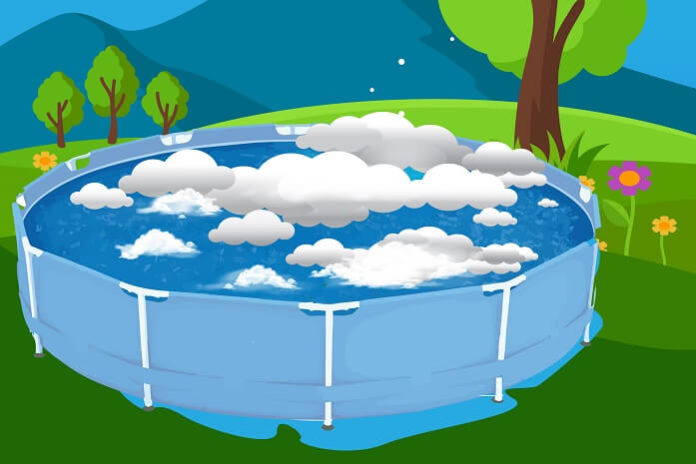You have to agree that enjoying a swimming pool is worth it. Pools soothe the infuriating heat in the summers and help you relax after a hectic day. However, after a couple of recreational sessions, you may realize that the quality of water becomes filthy and cloudy.
Thus, you need to change it often to avoid unhygienic conditions for you and your loved ones. The problem is that it is not that easy a task to accomplish.
It seems like you do not have to look anywhere, as this post will offer you the proper guide to overcome this unhygienic condition of your aboveground pool.
This post will share the reasons for such cloudiness in your pool as well as prudent ways to fix it. That said, let us dig into it to understand more about such a problem.
Table of Contents
Why Does the Water Become Cloudy?
While there can be many possible reasons for such an outcome, the most common ones are:
High level of pH
With the passage of time, the pH levels of your above ground swimming pool water will increase, which results in a translucent color of the water. These levels rise when you frequently use chlorine stabilizers or an HTH granular in the pool water to keep it hygienic.
Eventually, the high pH levels will reduce the effect of chlorine and similar disinfectants in the water, hence causing the water to turn cloudy. High PH levels also occur instantly which can turn the pool water milky or cloudy overnight.
Microscopic Debris
This issue happens when the debris of tiny size, floating in the water start populating, thus leading to a cloudy or translucent texture of the water. If your above ground pool is located in the open environment, the chances are that this will occur more frequently causing the water to lose its transparency.
Untreated water may even promote the growth of bacteria with time. Sometimes you may experience a green tone in the pool water due to algae and bacterial growth in the water.
How to Deal with the cloudy water?
The following list of steps will help you curb the unhygienic condition so that you can overcome the cloudiness in the water.
Step 1: Diagnose the Water
Check for chemical imbalances
Your first step should always be about testing the water. This is important so that the pool’s chemical balance is appropriate to start with the draining and cleaning afterward. If the chemical composition in your pool is not balanced, you may have first to balance it to move to the next step.
Test the pH level
Next, you need to check for the pH levels of your pool, which should be in the range of 7.2 to 7.6. Anywhere between these two numbers will ensure an appropriate pH level for your above ground pool.
Check for Chlorine levels that are free
This step involves you to check the free chlorine floating in the water.
Step 2: Removing cloudiness selectively when facing PH levels
If you have tested that the pH levels are too high, then you should tend to lower the pH level so that its cloudiness vanishes. Lower the standards with the help of chemicals that can decrease them.
If you have found that the pH levels are excellent, then it is highly likely that the issue is due to the microscopic level debris floating on the water. While checking it all, make sure to keep the free chlorine level noted as you are going to need that in a few steps.
How To Remove Cloudiness Due To Micro-level Debris?
If your pool’s cloudiness is not due to the rising PH level, then the chances are that it is due to the microscopic-level debris present in the water. Thus, the following methods can be implemented to solve this issue.
1. Using a Sand Filter to remove moderate cloudiness
This method is the most appropriate for the ones whose swimming pool is mildly cloudy. Besides, this method involves the use of Sand filter and not a cartridge or any other type of filter. To clear the water of the cloudiness, you will need a water clarifier.
- Start by backwashing the filter before proceeding with the cleaning of the debris through it. Remember that keeping the screen clean will enable you to filter out more pool water from the waste.
- Then, add the water clarifier in the pool as per the instructions on the back of the bottle. With the help of a clarifier, you are primarily accumulating the debris particles so that they become more prominent in size. This chemical is required for a sand filter as it is not as efficient as other filter pumps. This way they will not pass through the sand filter and stay in the pool water. You may need to add the necessary quantity as per the instructions for your pool size.
- Remember to keep the sand filter pump running for the next whole day to clear the water from the pollutants.
Do not miss back washing the filter once a day to until the cloudiness of the pool vanishes. Keeping the screen clean through this process enables you to clear the debris more efficiently.
2. Using A Floc to remove moderate to heavy cloudiness
This method is frequently used, which helps you clear the water of the cloudiness at a much faster rate. It involves the use of a chemical called Pool Floc that can be purchased from our local pool maintenance store. The steps that you are going to follow for this procedure are:
- Start by cleaning the filter pump (not a sand filter pump) you have for the pool. This step is essential so that you can have proper circulation and filtration to clear the milky or cloudy texture of the water.
- You will then fill the pool with water to the highest possible level. This step is done because in later steps you are going to vacuum some water out of the pool with the debris. Therefore, you want the level of the water stays maintained during this process.
- Add the pool Floc in the water as per the instructions on the backside of the packet.
- Keep the filter pump running for the next three hours so that the floc mixes with the water properly.
- After that, turn off the pump and let the pool water stay as it is overnight. The floc will cause the debris to become dense during all that time, thus making it settle down at the bottom of the pool. This process leaves the clear water above.
Use a dry/wet vacuum pump to suck all the settled debris out of the pool water. Use it slowly as vacuuming faster may cause the waste to float back in the pool water.
But, do not worry as floc can keep the debris dense for at least 24 hours so you can wait for it to settle down once again and then continue with the sucking process.
3. Using the Shocking method to clean moderate to heavy cloudiness
This method is suitable if you have ample time to clean the above ground pool. This step involves the use of a granular oxidizer that shocks the pool and helps the microscopic debris dissolve in the water.
- Start by cleaning the filter of your pool.
- Add the oxidizer in the water to shock the pool water. This step will work best when the free chlorine level in the water is low. If the free chlorine is high, then you may not need to use the oxidizer.
- Keep the pool pump running for the next whole day to provide it with circulation, which will help clean the debris faster.
Make sure to clean the filter two times in a day to keep it clear of the debris.
Bottom Line
Therefore, you can have finally learned the way to remove the cloudiness from your pool and enjoy it once again. Remember to maintain the circulation and sanitation of your pool to have a healthier time in it. Also, if you want have any issues or problems let us know in comments.










